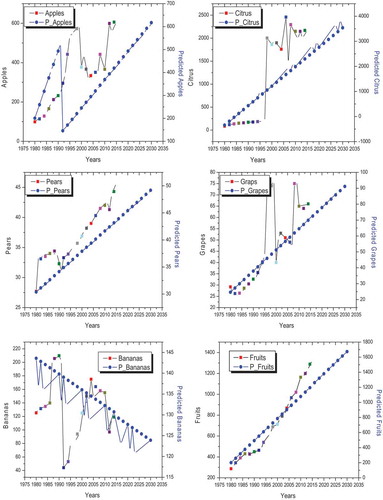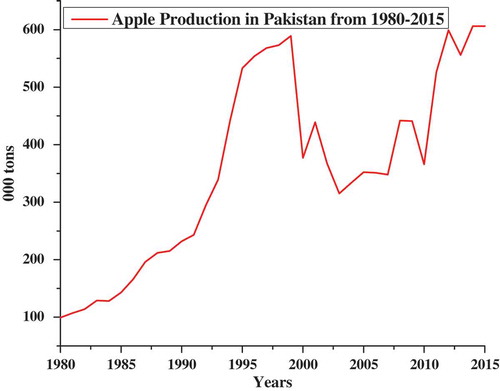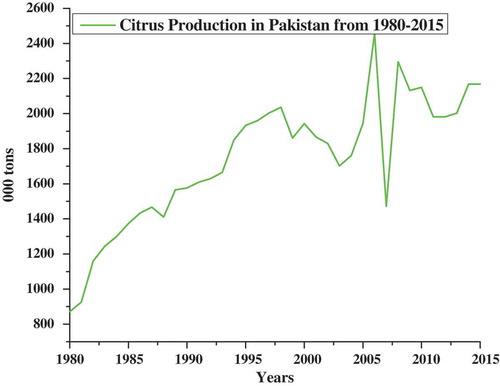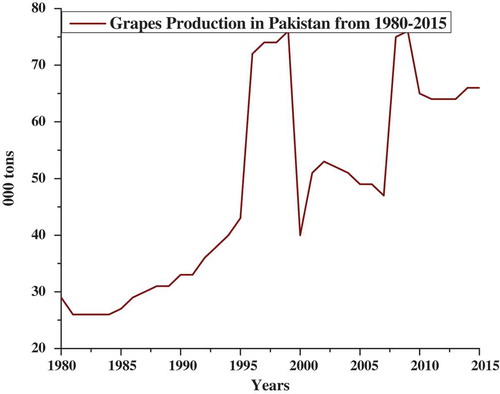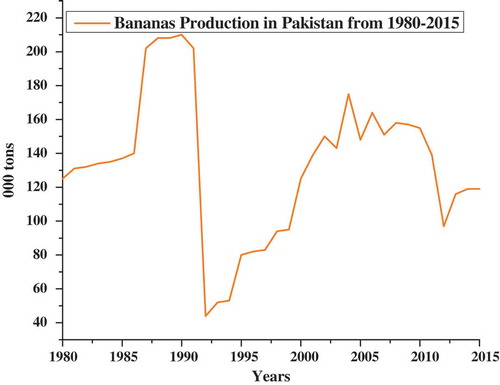ABSTRACT
The aim of this study was to use an econometric analysis to investigate the relationship between agricultural gross domestic product (AGDP) and variables such as apple, citrus, pears, grape and banana in Pakistan; data were explored from 1980 to 2015; we used time series data collected from secondary sources, including the Pakistan Bureau of Statistics, Statistical Year Books and the Economic Survey of Pakistan. Data were analyzed by using the Ordinary Least Square (OLS) method and Augmented Dickey Fuller (ADF) test, and results were interpreted by using the Johansen co-integration test. The machine learning technique was used to examine and predict the future agricultural productivity in Pakistan. We found that output of banana, citrus and pears had a positive and significant influence on AGDP, whereas apples and grapes had a negative but insignificant influence on AGDP.
Introduction
Fruits are good sources of antioxidants, vitamins and minerals, and are low in fat. Pakistan has a rich orchard heritage, especially in the harvest season and heritage. Because of its long shelf life, dried fruit can provide a good alternative to fresh fruit, especially during the winter season (Waheed and Siddique, Citation2009). Agriculture is important not only to feed the growing population of the world, but also because it is the backbone of Pakistan’s economy. It provides food for industry, and also raw materials. Plants feature energy-rich compounds, vitamins and minerals (especially citrus crops) and are important to the world, as they are produced by large-scale production and are available in extensive supply. It is called the rune family of the key genus. Many species of citrus fruits are well thought of in the Asian and Malaysian islands’ tropical and subtropical regions. It has carefully positioned potential values and is promoted in more than 52 countries around the world (Javaid et al., Citation2006).
The study demonstrates and examines the relationship between AGDP and all other dependent variables. OLS and ADF test were used to analyze the data and Johansen co-integration test was used to interpret the results. Finally machine learning technique was used to examine and predict the future production of fruits in Pakistan.
Major fruits production scenarios in Pakistan
Pakistan’s fruit are popular around the world and makes a rather long list. The most popular fruits within and outside country are apples, citrus fruit, bananas, guavas, peaches, grapes, mangoes, plums, watermelons and pomegranates. Pakistan has great diversity and privilege in its soil, ecological and climatic conditions, ranging from enormously severe to temperate. It creates a country in which to cultivate different kinds of trees, vines and creepers and shrubs that yield a huge variety of vegetables and fruits.
Apple production
Apples are the most important fruit crop in the temperate regions of the world, and they play a central role in folklore, culture and art at the level of production (Juniper and Mabberley, Citation2006). Dessert apples are popular because of their taste, nutritional characteristics, disease resistance and ease of use. New York beverages such as apple juice have been consumed by people of the Eurasian continent for centuries, even before the arrival of apples themselves. For centuries, humans have been developing, selecting and delivering apples, and have recorded some of the apple varieties (Morgan and Richards, Citation2003). The apple belongs to the Rosaceae family, as do other major temperate fruit trees (e.g., pear, apricot, peach, plum, cherry and almond trees). The genus Malus includes about 30 species and several subspecies, but the taxonomy of the genus is complex, unclear and may be revised in the future (Harris, Citation2002b). Due to the lack of diagnostic morphological features (De Queiroz, Citation1999), the delineation of apple species is hampered by the fact that the geographical extent of certain taxa and the prevalence of interspecific hybridization are documented. The hybridization between apples is due to the lack of interspecific breeding barriers, self-incompatibility, and the cultivation of apples in the natural occurrence of wild apple populations (Harris, Citation2002a).
In the temperate regions of the world, apple cultivation is considered to be important (Janick and Moore, Citation1996). The total number of species in the genus Malus varies between different studies, as Harris (Citation2002b) recognized 78 species, while Harris (Citation2002a) reported 55 species. Global apple production exceeded 75.4 million tons in 2013 (Sönmezoğlu and Kütük, Citation2014). Apples are Pakistan’s fourth largest fruit crop, and they are mainly grown in Khyber Pukhtunkhwa, Punjab and Baluchistan. Baluchistan is the biggest producer of apples. The varieties of apples being grown in Pakistan include Kala Kulu, Golden Delicious, Super, Gaja, Red Delicious, Mashadi, etc. (Muhammad et al., Citation2011). Jasra et al. (Citation2001) reported that Baluchistan’s (Pakistan) apple production declined significantly due to insect attacks as well as the selection of pollinizers. Therefore, the genetic polymorphism of existing varieties is accurately identified and evaluated, which is essential for successful apple breeding programs.
In most agricultural regions of the world, especially in developing countries where fertilizer is not affordable, the nutritional deficiencies in plants are widespread (Snapp et al., Citation2001). Increased efficiency in the absorption and utilization of soil nutrients may have a positive environmental impact. Growers can thus reduce their use of chemicals in agriculture and produce greater yields from the soil because the efficacy of fertilizers may be limited by chemical and biological reactions, topsoil dryness, subsoil constraints and disease interactions (Rengel and Damon, Citation2008).
The Baluchistan province of Pakistan is popular due to its apple production which has special significance among other growing fruits. The environmental condition for the production of apples in Pakistan is very suitable and is planted over the largest area. The total area of apple fruit cultivation is about 45,875 hectares with an annual production of 589,281 tonnes. The production of apples during the period from 1980 to 2015 is shown in in thousands of tonnes.
Citrus production
Citrus is native to Southeast Asia (Webber et al., Citation1967) and is now grown in tropical and subtropical regions around the world. Despite the extreme sensitivity of citrus to freezes (Huang et al., Citation1993; Wiltbank and Oswalt, Citation1987), the main production is concentrated in the subtropical regions, where the risk of freezing is low but still present. This is largely because while citrus trees bear fruit year-round in the tropics, the fruit quality is greatly improved by dormancy and single, yearly flowerings and fruit bearings. Cool temperatures (Poerwanto and Inoue, Citation1990; Susanto and Nakajima, Citation1990; García‐Luís et al., Citation1992) and possibly water stress (Southwick and Davenport, Citation1986) can induce a period of dormancy. Citrus is also susceptible to high temperatures. During the flowering or early fruit setting, excessively warm temperatures are known to cause the fruit to fall off the trees (Ono et al., Citation1988; Reuther, Citation1973).
Citrus is an important fruit tree crop, widely cultivated throughout the world, and Pakistan is one of the major countries engaged in citrus production (Abbas et al., Citation2013; Altaf et al., Citation2009). In Pakistan, citrus is widely distributed over 194,500 hectares with an annual output of 1.982 million tons during 2010–2011 (Agriculture Statistics of Pakistan, Citation2011). The important citrus species commercially grown in Pakistan are Citrus reticulata, Citrus sinensis, Citrus limon and Citrus paradisi. The majority of citrus orchards (95% of the total area) are located in Punjab province. The Kinnow Mandarin is the main variety in Punjab, growing on 70% of the total cultivated area (Altaf and Khan, Citation2008).
Citrus is considered to be one of the world’s leading fruit crops. It is harvested in many countries in tropical or subtropical climates, with major producers in Brazil, China, Japan, Mexico, Pakistan, the United States and the Mediterranean region. The world’s citrus production is about 105 tons per year, and the fruit of this genus is mainly processed into fruit juice. Juice industry residues, such as the skin, seeds and pulp, represent about 50% of the processed fruit, and are a source of valuable by-products (Anwar et al., Citation2008).
Pakistan has sixth rank in the world for its production of citrus/orange of 2.1 million tonnes. According to estimates, 95% of the world’s total production of the particular citrus variety, kinow, is grown in Pakistan. The production of citrus fruit during the period from 1980 to 2015 is shown in in thousands of tonnes.
Pear production
There are more than 2000 pear varieties, but only a few are commercially cultivated. Pears are usually eaten fresh and are also used to produce fruit juices, purees and jam (Raffo et al., Citation2011; Silva et al., Citation2014). The quality of the pear is known to be influenced by external characteristics (size, shape and color) and internal characteristics (nutrition and taste quality) (Choi et al., Citation2007). Pears have a high nutritional value, as they contain an appropriate amount of sugar, amino acids and minerals such as sodium, potassium, calcium, magnesium and iron (Yim and Nam, Citation2016).
The pears from Pakistan are cultivated in a temperate zone of the world and have a high nutritive value and are tasty. The cultivation of pear crop is steadily increasing, especially in Asia. The production of pears fruit during the period 1980–2015 is shown in in thousands of tonnes.
Grape production
The grapes are one of the most important fruits in the world economically, and now the world has 8000–10,000 grape varieties (Ramezani et al., Citation2009), and most of the breeds are made from a species subspecies because it has high-quality berries. However, subspecies are very sensitive to fungal diseases, leading to serious loss of grape production (Wan et al., Citation2008). On the other hand, subspecies has a narrow genetic background, grape breeders are working to use wild germplasms to improve the variety of disease resistance, cultivate disease-resistant varieties (Brown et al., Citation1999). Grape is the main source of natural yeast in wine production. The quality of the grape wine flora can be beneficial or harmful, so there is more information needed about yeast in wine and present grapes are very important for wine producers to produce high-quality and representative property of wines. A large number of ecology studies have been carried out on different strains of yeast in different producing areas (Chavan et al., Citation2009; Combina et al., Citation2005; Nisiotou and Nychas, Citation2007; Raspor et al., Citation2006). It has been found that freshly crushed grape juice harbors a diversity of yeast species, principally within the genera Hanseniaspora (anamorph Kloeckera), Pichia, Candida, Metschnikowia and Kluyveromyces. Occasionally, species in other genera such as Cryptococcus, Rhodotorula, Debaryomyces, Issatchenkia, Zygosaccharomyces, Saccharomycodes, Torulaspora, Dekkera, Schizosaccharomyces and Saccharomyces have also been isolated from wine grapes of several wine-producing areas (Fleet, Citation2003; Jolly et al., Citation2006; Prakitchaiwattana et al., Citation2004).
In Pakistan only the European types of grapes are cultivated for eating. In the country, 70% of grapes are grown in the Baluchistan province. The production of grapes during the period 1980–2015 is shown in in thousands of tonnes.
Banana production
A banana (Musa spp.) is an important global food, providing about 25% of food energy needs of 100 million people. It grows in more than 140 countries of tropical and subtropical, with annual world production of about 145 million tons. About one-third of global production comes from Africa, and more than 40% of crops are grown in East Africa (FAOSTAT, Citation2014). In recent years, the production of banana breeders in East Africa has declined due to parasitic nematodes, bacterial and fungal infections. Banana Fusarium wilt (BXW) caused by cabbage. Musacearum is one of the most important diseases of bananas and is considered to be the biggest threat to banana production in the Great Lakes region of East Africa (Tripathi et al., Citation2009). Banana is an important fruit crop in the world’s wet lowlands and tropical regions. Bananas are also widely planted as plant crops for desert fruit sale. The main banana growing area of Sindh province are Thatta, Nawabshah, Noeshero Feroze, Badin, Hyderabad, Mirpurkhas, Sanghar and Khairpur (Saif & Soomro, Citation1992).
In the tropics, bananas have a high socio-economic importance because it is an export-oriented plantation’s cash crop and a small farm farm’s food and cash crops. Bananas are a robust crop that has a higher return on input, but the production of certain breeds is often limited by Panama’s disease (Fusarium wilt), a wilt disease caused by the soil-borne fungus Fusarium oxysporum f.sp. cubense (Foc) (de Oliveira e Silva, Citation2001).
Bananas are also a main fruit crop of Pakistan. Bananas are produced on 34,800 hectares yielding a production of 154800 tonnes. The Sindh province of Pakistan is ideal for banana production, where climatic conditions are favourable for its cultivation. In 1992 it faced some serious problems from production through to post-harvest management and marketing. Different banana exporters, growers, government employees and contractors expressed shock that the post-harvest failure of bananas amounted to 30– 45% of entire production. Production of bananas during the full period 1980–2015 is shown in in thousands of tonnes.
Materials and methods
Time series annual data were used in this study from 1980 to 2015 in order to study the relationship between the dependent and independent variables. The variables used in this research were: Agricultural Gross Domestic Product (AGDP) in (million rupees), output of apple in (000, tons), output of banana (000, tons), output of citrus (000, tons), output of grapes (000, tons) and output of pears (000, tons) respectively.
Model specification
To check the relationship between agricultural gross domestic product (AGDP) and the outputs of the major fruits, the following model was specified for estimating:
Equation (1) can also be written as;
Taking the natural logarithm of equation (2) and its five explanatory variables converts equation (2) to the following form:
Where
β0 = Natural logarithm of A, the intercept; lnZ = Natural logarithm of AGDP per year in (million rupees); lnY1 = Natural logarithm of output of Apple in (000, tons); lnY2 = Natural logarithm of output of Banana in (000, tons); lnY3 = Natural logarithm of output of Citrus in (000, tons); lnY4 = Natural logarithm of output of Grapes in (000, tons); lnY5 = Natural logarithm of output of Pears in (000, tons); µ = error term
So, equation (3) can also be written as:
ADF unit root test was used to check the stationarity of the variables. After checking the stationary of the series, Johansen Co-integration test was employed to check the long-run relationship between the dependent and independent variables, and finally OLS econometric technique was used to examine the impact of dependent variables on the AGDP for Pakistan.
Ordinary least square method (OLS)
The results of this method were used to indicate the predictive ability of the model, as well as the relative statistics about the variables in the short-run. To check the long-run relationship between the dependent and independent variables, the Johansen Co-integration test was used.
Results and discussion
Results of unit root test
The estimated results of the Augmented Dickey Fuller (ADF) test as presented in show that all variables have not attained stationarity at their level form, while all variables did became stationary after taking the first difference I(1), as indicated by the values of the ADF statistics test being greater than the critical values at the 5% and 10% of significance level.
Table 1. ADF unit root test including trend and intercept.
Co-integration test
The results of the co-integration test were based on Johansen’s Co-integration test. Two tests were used: trace statistics and maximum eigenvalue. The presence of a co-integration use shows that AGDP, output of apple, output of banana, output of citrus, output of grapes and output of pears have a long-run equilibrium relationship. The estimated results of the Johansen Co-integration tests are presented in and . The value of the Trace statistic (160.9524) and the value of Max-Eigen statistic (80.44490) were greater than their critical values (95.75366), (40.07757), which signals that there is a long-term relationship amongst the dependent and independent variables. This means, the test rejects the null hypothesis of no co-integration. From both tests, the trace statistic and the Max-Eigen statistic reveal that the co-integrating equation is valid at the 5% level.
Table 2. Johansen co-integration test using trace statistic.
Table 3. Johansen co-integration test using Max-Eigen statistic.
Results of regression analysis
To examine the relationship between the output production of major fruits and AGDP in Pakistan, the OLS method was employed. The results of the regression analysis are reported in . From the OLS regression results, the high value of R2 is 0.909 or 90.0% and the adjusted-R2 is 0.894 or 89.4%. This implies that about 90% of the total change in AGDP is described by the explanatory independent variables. The computed value of the F-statistic is 60.22332 with a probability value of 0.000000, which shows that the overall goodness of fit of the model is significant.
Table 4. Regression analysis.
The results of the regression analysis revealed that the coefficient of output of pear fruit is highly significant at both the 1% and 5% level of significance, which showed that there is a strong and positive relationship between the output production of apples and AGDP. This implies that a 1% intensification in the output of pears results in an AGDP increase of 6.90% with a standard error of 1.335868, a t-statistic value of 5.170616 and probability = 0.0000. The results further show that the coefficients of output of banana and citrus fruit have positive relationship with AGDP. This means that a 1% increase in the output of bananas and citrus fruit shows coefficients of 0.06% and 0.47%, but statistically both are insignificant. Similarly, the regression result shows that apple and grapes have a negative relationship with AGDP, with coefficients −0.096913 and −0.129331. It means statistically that apple and grapes are insignificant. The results shows that the coefficient of the output of apple and grapes is not highly significant at both the 1% and 5% of level of significance, which showed that there is a negative relationship between agricultural AGDP and the output of grapes. The output of pears is highly significant at both the 1 and 5% of levels of significance, which indicates that a positive relationship between the output of grapes and AGDP. Our results for pears found out a positive relationship between the outputs of pears with AGDP. Recently, the fruit sector of Pakistan was faced with numerous problems, such as deficiency of irrigation, underdeveloped infrastructure facilities, poor agricultural marketing, lack of funding and the rising prices of major agricultural inputs.
Prediction of major fruits production by using machine learning technique
Machine learning technique was used to predict the future production of major fruits in Pakistan. Linear regression was used for the study variables and results were interpreted by using the statistical classification techniques, so the model specification of linear regression is specified as;
where T denotes the transpose, and is the inner product between vectors xi and β.
So the vector form is = Y = X +
The confidence interval of E (y|) and the average of expected value of y for a specific given
.
where Sy is the standard deviation of the residuals, calculated as and Sy is called residual standard error in R regression output.
The proposed model is consisting of m vectors in a d dimensional feature space. In the feature space x points, which project it on m and convert it into z real number, the range of the real number is −∞ to + ∞.
Through confusion matrix accuracy can be calculated as:
where TP indicates True Positive, TN indicates True Negative, FP indicates False Positive and FN indicate False Negative. Trend is up but it is classified as down.
Algorithm 1:
Agriculture Fruit Production Prediction
Input: A set of fruit data X
Output: Fruit data X future Prediction P
Algorithm
Step 1: Take matrix M of last one year data, data size 1 × 6
Step 2: Take matrix P of 40 years pervious data, data size 35 × 6
Step 3: Make sliding window of window size 1 × 6 for each matrix P as W1, W2…W35
Step 4: Compute Euclidean distance of sliding window D1, D2, D3…. D35
Step 5: Select matrix Wi as
∘ Wi = corresponding matrix (min Di)
∘
Step 6: For I = 1 to n
For computer the moving average of matrix D as Q
For computer the central moving average matrix Q as R
Mean 1 = mean of Q
Mean 2 = mean of R
Prediction P = (Mean1+Mean2) / 2
Add P to pervious data for getting forecasting
Step 7: End
The population of Pakistan is increasing continually and more production is needed in the fruits with increasing population. It is responsibility of the government to provide all facilities to the farmers to increase the production of fruits. shows the current production (2015) and the future production forecasting (2030) of fruits in Pakistan.
Table 5. Data and results.
Conclusion and recommendations
Fruits production is an important component of agriculture and performs a very supportive economic role in the country. In this study time series data were used from 1980 to 2015, and data were collected from the National Food Security and Research, the Pakistan Bureau of Statistics and the Economic Survey of Pakistan. Fruits data were analyzed using the OLS method and the ADF unit root test, and the results were interpreted using the Johansen co-integration test, finally machine learning technique was used to predict the future production of fruits in Pakistan. Study results show that the outputs of banana, citrus and pears have a positive, significant relationship with Pakistan’s AGDP, while the outputs of apples and grapes have a negative, insignificant relationship with Pakistan’s AGDP.
Hence, the study recommends that the government of Pakistan identifies novel funding schemes to increase the production of apples and grapes and adopts better policies for the production and development of the fruits sector.
Acknowledgments
The authors are grateful to the Research Center of Agricultural-Rural-Peasants, Anhui University Hefei, China for it moral support. Moverever, the authors are also indebted to the reviewers for their positive suggestions that helped to improve the content of this study.
References
- Abbas, M., M.M. Khan, S.M. Mughal, and P. Ji. 2013. Characterization and assessment of seasonal variation of Citrus tristeza closterovirus (CTV) in citrus in Pakistan. J. Food. Agric. Environ. 11(3&4):1063–1068.
- Agriculture Statistics of Pakistan. 2011. Government of Pakistan statistics division Pakistan Bureau of Statistics. Islamabad. p. 89.
- Altaf, N., and A.R. Khan. 2008. Variation within kinnow (Citrus reticulata) and rough lemon (Citrus jambheri). Pak. J. Bot. 40(2):589–598.
- Altaf, N., A.R. Khan, L. Ali, and I.A. Bhatti. 2009. In vitro culture of kinnow explants. Pak J. Bot. 41(2):597–602.
- Anwar, F., R. Naseer, M.I. Bhanger, S. Ashraf, F.N. Talpur, and F.A. Aladedunye. 2008. Physico-chemical characteristics of citrus seeds and seed oils from Pakistan. J. Am. Oil Chemists’ Soc. 85(4):321–330. doi: 10.1007/s11746-008-1204-3.
- Brown, M.V., J.N. Moore, P. Fenn, and R.W. McNew.1999. Evaluation of grape germplasm for downy mildew resistance. Fruit Varieties J.
- Chavan, P., S. Mane, G. Kulkarni, S. Shaikh, V. Ghormade, D.P. Nerkar, … M.V. Deshpande. 2009. Natural yeast flora of different varieties of grapes used for wine making in India. Food Microbiol. 26(8):801–808. doi: 10.1016/j.fm.2009.05.005.
- Choi, J.H., J.J. Choi, K.H. Hong, W.S. Kim, and S.H. Lee. 2007. Cultivar differences of stone cells in pear flesh and their effects on fruit quality. Hortic. Environ. Biotechnol. 48(1):27–31.
- Combina, M., L. Mercado, P. Borgo, A. Elia, V. Jofré, A. Ganga, … C. Catania. 2005. Yeasts associated to Malbec grape berries from Mendoza, Argentina. J. Appl. Microbiol. 98(5):1055–1061. doi: 10.1111/j.1365-2672.2005.02540.x.
- De Queiroz, K., 1999. The general lineage concept of species and the defining properties of the species. In Species: new interdisciplinary essays. MIT Press.
- de Oliveira e Silva, S., Teixeira Souza Junior, M., Alves, É.J., Silva Silveira, J.R., Bezerra Lima, M., 2001. Banana breeding program at Embrapa. Crop Breed. Appl. Biotechnol. 1, 399–436.
- FAOSTAT, 2014. Food and agriculture organization of United Nation. http://www.fao.org/faostat.
- Fleet, G.H. 2003. Yeast interactions and wine flavour. Int. J. Food Microbiol. 86(1):11–22. doi: 10.1016/S0168-1605(03)00245-9.
- García‐Luís, A., M. Kanduser, P. Santamarina, and J.L. Guardiola. 1992. Low temperature influence on flowering in Citrus. The separation of inductive and bud dormancy releasing effects. Physiol Plant 86(4):648–652. doi: 10.1111/j.1399-3054.1992.tb02182.x.
- Harris, S.A., J.P. Robinson, and B.E. Juniper. 2002a. Genetic clues to the origin of the apple. TRENDS Genet. 18(8):426–430. doi: 10.1016/S0168-9525(02)02689-6.
- Harris, S.A., J.P. Robinson, and B.E. Juniper. 2002b. Taxonomy of the genus Malus Mill. (Rosaceae) with emphasis on the cultivated apple, Malus Domestica Borkh. Plant Syst. Evol. 226(1–2):35–58. doi: 10.1007/s006060170072.
- Huang, S., G. Li, C. Zhou, X. Fan, C. Shen, and M. Xue. 1993. A climatological study of injury to citrus trees from freezing weather in China. Agricul. Forest Meteorol. 65(1–2):129–138. doi: 10.1016/0168-1923(93)90041-F.
- Janick, J., and J.N. Moore. 1996. Fruit breeding. Tree and Tropical Fruits. Inc, Oxf., UK, p. 77.
- Jasra, A.W., S.A.B.I.R.A. Ashfaq, and M.A. Kasi. 2001. Apple pollination problems in Balochistan, Pakistan. Int. J. Agri. Biol. 3:210–213.
- Javaid, M.A., M.A. Tariq, and A.A. Asi. 2006. Effect of micronutrients application on the yield and quality of kinnow Mandarin. Citrus Reticulata Blanco 38:169–172.
- Jolly, N.P., O.P.H. Augustyn, and I.S. Pretorius. 2006. The role and use of non-Saccharomyces yeasts in wine production.
- Juniper, B.E., and D.J. Mabberley. 2006. The story of the apple Imber Press. Portland, Oregon, USA.
- Morgan, J., and A. Richards. 2003. The new book of apples brogdale horticultural trust.
- Muhammad, A., M. Ayub, A. Zeb, Y. Durrani, J. Ullah, and S.U.R. Afridi. 2011. Physicochemical analysis of apple pulp from Mashaday variety during storage. Agric. Biol. JN Am. 2:2.
- Nisiotou, A.A., and G.J.E. Nychas. 2007. Yeast populations residing on healthy or Botrytis-infected grapes from a vineyard in Attica, Greece. Appl. Environ. Microbiol. 73(8):2765–2768. doi: 10.1128/AEM.01864-06.
- Ono, S., K. Hirose, T. Takahara, I. Iwagaki, and K. Yoshinaga, 1988. Studies on physiological fruit drop in mid and late maturing citrus cultivars, 1: inter-cultivar difference and relationship between physiological fruit drop and ecological factors. Bulletin of the Fruit Tree Research Station. Series D. Kuchinotsu, Japan.
- Pathan, M.A., M.A. Talpur, M.M. Jiskani, and K.H. Wagan. 2004. Studies on plant parasitic nematodes associated with banana in Sindh, Pakistan. J. Asia Pac. Entomol. 7(2):249–252. doi: 10.1016/S1226-8615(08)60223-X.
- Poerwanto, R., and H. Inoue. 1990. Effects of air and soil temperatures on flower development and morphology of satsuma mandarin. J. Hortic. Sci. 65(6):739–745. doi: 10.1080/00221589.1990.11516116.
- Prakitchaiwattana, C.J., G.H. Fleet, and G.M. Heard. 2004. Application and evaluation of denaturing gradient gel electrophoresis to analyse the yeast ecology of wine grapes. FEMS Yeast Res. 4(8):865–877. doi: 10.1016/j.femsyr.2004.05.004.
- Raffo, M.D., N.M. Ponce, G.O. Sozzi, A.R. Vicente, and C.A. Stortz. 2011. Compositional changes in ‘Bartlett’pear (Pyrus communis L.) cell wall polysaccharides as affected by sunlight conditions. J. Agric. Food Chem. 59(22):12155–12162. doi: 10.1021/jf203950d.
- Ramezani, A., R. Haddad, M. Dorostkar, M. Mardi, and M. Naghavi. 2009. Evaluation of genetic diversity of Iranian grapevine accessions using microsatellite markers. Vitis 48(3):151–152.
- Raspor, P., D.M. Milek, J. Polanc, S.S. Možina, and N. Čadež. 2006. Yeasts isolated from three varieties of grapes cultivated in different locations of the Dolenjska vine-growing region, Slovenia. Int. J. Food Microbiol. 109(1):97–102. doi: 10.1016/j.ijfoodmicro.2006.01.017.
- Rengel, Z., and P.M. Damon. 2008. Crops and genotypes differ in efficiency of potassium uptake and use. Physiol Plant 133(4):624–636. doi: 10.1111/ppl.2008.133.issue-4.
- Reuther, W. 1973. Climate and citrus behavior. Citrus Industry 3:280–337.
- Saif, K., and M.H. Soomro. 1992. Bunchy top banana disease and their control. Progressive Farming 12: 29–31.
- Silva, G.J., T.M. Souza, R.L. Barbieri, and A. Costa De Oliveira. 2014. Origin, domestication, and dispersing of pear (Pyrus spp.). Advances in Agriculture.
- Snapp, S., H. Borden, and D. Rohrbach. 2001. Improving nitrogen efficiency: lessons from Malawi and Michigan. Scientific World J. 1:42–48. doi: 10.1100/tsw.2001.307.
- Sönmezoğlu, Ö.A., and A. Kütük. 2014. Determination of genetic diversity among Karaman apple landraces. J. Food. Agric. Environ. 12(1):52–54.
- Southwick, S.M., and T.L. Davenport. 1986. Characterization of water stress and low temperature effects on flower induction in citrus. Plant Physiol. 81(1):26–29. doi: 10.1104/pp.81.1.26.
- Susanto, S., and Y. Nakajima. 1990. Effect of winter heating on flowering time, fruiting and fruit development in pummelo grown under plastic house. J. Jpn. Soc. Hortic. Sci. 59(2):245–253. doi: 10.2503/jjshs.59.245.
- Tripathi, L., M. Mwangi, S. Abele, V. Aritua, W.K. Tushemereirwe, and R. Bandyopadhyay. 2009. Xanthomonas wilt: a threat to banana production in East and Central Africa. Plant Dis. 93(5):440–451. doi: 10.1094/PDIS-93-5-0440.
- Waheed, S., and N. Siddique. 2009. Evaluation of dietary status with respect to trace element intake from dry fruits consumed in Pakistan: a study using instrumental neutron activation analysis. Int J Food Sci Nutr 60(4):333–343. doi: 10.1080/09637480801987641.
- Wan, Y., Y. Wang, D. Li, and P. He. 2008. Evaluation of agronomic traits in Chinese wild grapes and screening superior accessions for use in a breeding program. Vitis 47(3):153–158.
- Webber, H.J., W. Reuther, and H.W. Lawton.1967. History and development of the citrus industry. p. l–39. In: ed. Reuther W., Webber H.J., and Batchelor L.D. The Citrus industry. Vol. I, University of Calif. Div. Agric. Sci, Berkeley, CA.
- Wiltbank, W.J., and T.W. Oswalt, 1987. Low temperature killing points of citrus leaves during the 1984–85, 1985–86 and 1986–87 low temperature periods in Florida. In Proceedings of the Florida State Horticultural Society Vol. 100, pp. 113–115.
- Yim, S.H. and Nam, S.H. 2016. Physiochemical, nutritional and functional characterization of 10 different pear cultivars (Pyrus spp.). Journal of Applied Botany and Food Quality, Mar 22;89.

